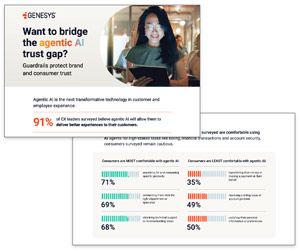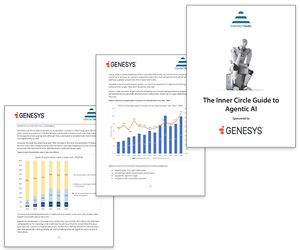Greg Thomas at Genesys explores how brands can use AI and emotional intelligence to build deeper customer connections and drive lasting loyalty in an increasingly digital world.
Consumers today want more. They seek meaningful relationships with the brands they interact with. They crave a real connection that offers empathy and demonstrates shared values.
At the same time, modern customer loyalty is fleeting, and even just one bad experience can send some customers running.
According to the 2024 our “The State of Customer Experience” report, 86% of consumers surveyed say a company is only as good as its service.
And one-third have switched brands in the past year due to a negative interaction. Building a customer journey that creates seamless experiences – no matter their goal or channel – is crucial to avoiding that churn.
Delivering effective, efficient and empathetic customer experiences can be critical factors in building brand loyalty. And one way to deliver those experiences is through digital transformation to an artificial intelligence (AI)-powered customer engagement platform.
The Role of Emotion in Customer Experience Marketing Strategy
Emotions can influence what we buy, shape how we view brands and affect our loyalty. Providing customers with the empathetic experience they seek requires building an emotional connection at all stages of the customer journey – from marketing and advertising to after-sales customer support.
Leading brands have long known that emotional branding can enable them to build a connection by tapping into customers’ aspirations and needs.
Emotional branding requires an authentic brand personality, knowing your customer’s behaviour and triggers and, increasingly, delivering personalised customer experiences.
It’s easy to recognise the leaders in emotional branding. They’re brands that have captured our attention and appeal to our needs and aspirations. Often, they sell experiences, not products.
Building a Customer-Centric Culture
Today’s shifting consumer preferences and behaviours require an increasingly customer-centric approach to earning and maintaining loyalty.
Your customer experience teams are critical to customer satisfaction; they should be well-trained and equipped with the tools to deliver great customer experience.
AI tools are playing a huge part in this. In fact, two-thirds of CX leaders surveyed for the our report “Customer experience in the age of AI” say that adopting AI technologies will make employees in their organisations more engaged.
And many organisations are shifting to AI-powered workforce engagement management tools to improve the overall employee experience.
About one-fifth of CX leaders surveyed for the report say they’re using automated coaching and training tools, 44% of which are AI-powered.
Using Data to Personalise Experiences
Aligning your business with customer goals and creating personalised experiences requires customer data – which organisations today gather from a variety of touchpoints and sources.
Using customer journey management tools, organisations can turn that wealth of data into actionable customer insights that help them to deliver end-to-end personalised experiences no matter the channel.
Equipped with the data they need, organisations can:
- Identify journeys that matter to customers and business outcomes.
- Measure and monitor the in-journey signals that predict success.
- Take corrective action, when needed.
- Track journey success.
- Prioritise journeys that perform poorly to make improvements.
Personalisation should be ongoing and implemented across channels.
Enhancing Digital Interactions
In 2022, digital channels overtook voice in terms of customer interactions, shows data from the “State of customer experience” report. In fact, 72% of consumers used email for customer interactions, while only 68% called a contact centre.
Despite this, customer satisfaction with all channels except voice has declined, shows the report. This is because many organisations lack a fully connected channel-less approach, resulting in data silos, lack of visibility into performance and missed opportunities for personalisation.
As more customers desire asynchronous and self-serve experiences, AI and automation becomes even more essential to providing seamless service over the long term.
The popularity of using chatbots and virtual agents continues to grow. In fact, some 88% of CX leaders surveyed for “Customer experience in the age of AI,” are using chatbots to support customer experiences; 92% say those chatbots are AI-powered.
Integrating Omnichannel and Channel-Less Strategies
Your brand experience must be the same at every touch point and channel. You need to seamlessly meet customers with exceptional CX in the channel most relevant to them.
Giving customers and prospects a channel-less experience – where communication across channels is a seamless, unbroken conversation – is how companies will differentiate from their competitors.
Customer Experience Strategy Metrics
As customer expectations have evolved, the way we measure their satisfaction hasn’t kept up. Traditional metrics like Net Promotor Score, don’t often establish the source of customer frustration.
Key metrics to assess the customer experience fall into three areas:
- Perception metrics relate to what your customers expect from their overall experience with your enterprise; Voice of the Customer (VoC) programs are the common way to capture this metric.
- Interaction metrics look at what happens as customers work to achieve their goals, using data from your website, contact centre, and physical store or branch locations.
- Outcome metrics look at perception and interaction to measure the result of your customers’ experience with your organisation. These metrics are based on business outcomes and behavior you want to see from your customers, including acquisition, cost reduction, increasing revenue per user and more.
Organisations must identify and address some of the common pitfalls to CX: lack of visibility into the customer journey, lack of channel integration, personalisation shortcomings, long wait times and more.
By adopting AI-powered customer journey management tools, companies can more easily find points of frustration in the customer journey and take corrective measures.
Rich customer journey management tools can provide necessary visibility into customers’ experiences and give organisations actionable insights to make improvements, if needed. These tools can enable you to track customer behaviour and pain points to understand your customers and drive loyalty.
The Rise of AI in Personalisation
Building and retaining brand loyalty today requires a seamless, tailored customer experience. AI technology and machine learning can be powerful tools for improving both the customer and the employee experience.
As an organisation’s AI use matures, they can increase personalisation at scale – tailoring experiences based on customer behaviour and history.
Advanced technologies like AI, virtual agents and copilots – which assist customer service agents in real time – can enable you to increase personalisation at scale and to take your customer experience (and employee experience) to new heights.
This blog post has been re-published by kind permission of Genesys – View the Original Article
For more information about Genesys - visit the Genesys Website
Call Centre Helper is not responsible for the content of these guest blog posts. The opinions expressed in this article are those of the author, and do not necessarily reflect those of Call Centre Helper.
Author: Genesys
Reviewed by: Megan Jones
Published On: 29th Apr 2025
Read more about - Guest Blogs, Genesys






 Genesys empowers more than 8,000 organisations in over 100 countries to improve loyalty and business outcomes by creating the best experiences for their customers and employees. Through Genesys Cloud, the AI-Powered Experience Orchestration platform, Genesys delivers the future of CX to organisations of all sizes so they can provide empathetic, personalised experience at scale. As the trusted platform that is born in the cloud, Genesys Cloud helps organisations accelerate growth by enabling them to differentiate with the right customer experience at the right time, while driving stronger workforce engagement, efficiency and operational improvements.
Genesys empowers more than 8,000 organisations in over 100 countries to improve loyalty and business outcomes by creating the best experiences for their customers and employees. Through Genesys Cloud, the AI-Powered Experience Orchestration platform, Genesys delivers the future of CX to organisations of all sizes so they can provide empathetic, personalised experience at scale. As the trusted platform that is born in the cloud, Genesys Cloud helps organisations accelerate growth by enabling them to differentiate with the right customer experience at the right time, while driving stronger workforce engagement, efficiency and operational improvements. 












